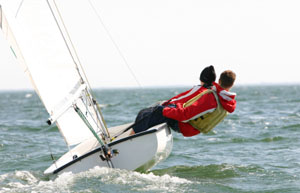
For an exhilarating sailing experience which is easy to start and full of fun, there is no better way to enter the sport than with dinghy sailing.
Where to start
You'll find many dinghy sailing clubs around the lakes and rivers of the UK coast. Always keen to take on new members, especially families, you'll find them welcoming and friendly.
Cost
Fees vary depending on the level of facilities, but a good club will cost around £150 per year for a family and may include a dinghy parking place. Individuals joining on their own will expect to pay around £50 per year. There are no fees to use the water but you will need insurance. This should cost a further £50.
Equipment
There are two vital pieces of equipment that you will need. A buoyancy aid or life jacket and a pair of non-slip shoes. Trainers are fine to begin with but they offer no protection from the water. You'll also need to invest in a good waterproof jacket in the summer and a wetsuit for the winter months. Wearing layers of clothing is always advisable.
Buying a dinghy
Some clubs will lend you a boat and a sailing centre will provide a boat as part of a course. It's a good idea not to rush in and buy a dinghy straight away. It's best to start with a used dinghy while you're new to sailing. Beginners to the sport will normally start with an older boat and after a few months, when you're sure you want to continue, you can upgrade to something to a newer boat.
View our Sailing dinghies for sale
Types of dinghy
- Car portable such as Toppers
- Fixed keel dinghies
- Performance dinghies such as Catamarans
- One person dinghies like the One Man Lasers
- Two person such as Fireballs
- Family dinghies like Wayfarers
Courses
Dinghy sailing is always taught by RYA qualified instructors starting with beginners courses. Courses are designed so that the skills you learn in one boat are transferable to the next. And you can complete courses in stages, so you can finish one section and continue with the next when you are ready – on holiday for instance.
Learning to sail on holiday
Learning to sail a dinghy on holiday is a great way to enter the world of sailing. With better weather and time on your side, you'll feel more relaxed and possibly learn to sail much faster. With warmer waters you'll almost certainly feel more confident when you capsize the dinghy.
Inshore lakes or costal waters
Dinghy sailing on an inshore lake is generally considered safer. You'll be sailing within easy distance of a rescue boat, making it popular with families. It's also easier to lean this way. Without the distraction of the tide and avoiding other craft, you'll feel more comfortable able to concentrate fully on your sailing. With stronger winds and greater challenges, coastal sailing is for the more experienced dinghy sailor.
Start racing
It won't be long before you feel ready to start racing and most clubs run novice courses. Boats designed for one or two people, and even high performance dinghies with a crew, can be raced without any official qualification. You will, however, need to learn to handle the dinghy and have a good grasp of the basics for your own safety.
Cruising
There is the option to cruise rather than race and there are clubs for people who simply wish to sail with others and discover new waters. Smaller boats for cruising are slightly different in that they are not designed for speed but for comfort. This means they handle easily in all weathers and are safer when away from shore with no rescue boat. Larger and heaver dinghies are known as day boats. You will also need to complete a course for cruising and have a good understanding of the basics.
Buying a dinghy
Before you buy a dinghy you must bear in mind that your requirements will change as your sailing develops. You should also consider whether you want to sail alone or with a crew, if it needs to be portable and if you need a faster performance boat more or one more suitable for cruising. Newer, high performance boats will come at a higher price but there are bargains to be had with older boats.